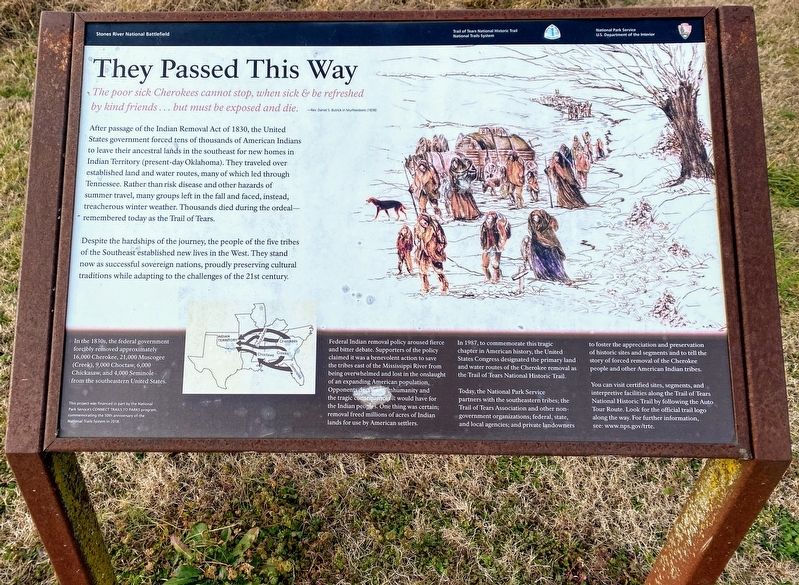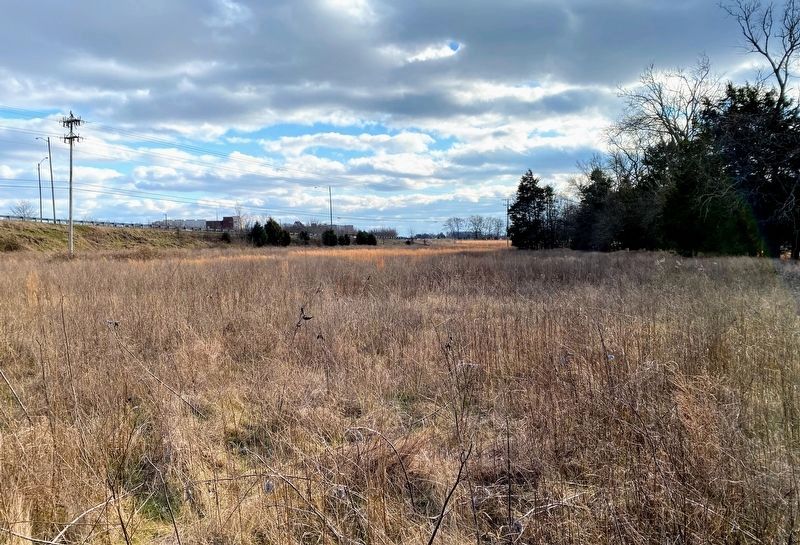Murfreesboro in Rutherford County, Tennessee — The American South (East South Central)
They Passed This Way
Stones River Battlefield
— Trail of Tears National Historic Trail, National Trails System —
The poor sick Cherokee cannot stop, when sick & be refreshed by kind friends… but must be exposed and die." - Rev. Daniel S. Butrick in Murfreesboro (1838)
After passage of the Indian Removal act of 1830, the United States government forced tens of thousands of American Indians to leave their ancestral lands in the southeast for new homes in Indian Territory (present-day Oklahoma). They traveled over established land and water routes, many of which led through Tennessee. Rather than risk disease and other hazards of summer travel, many groups left in the fall and faced, instead, treacherous winter weather. Thousands died during the ordeal - remembered today as the Trail of Tears.
Despite the hardships of the journey, the people of the five tribes of the Southeast established new lives in the West. They stand now as successful sovereign nations, proudly preserving cultural traditions while adapting to the challenges of the 21st century.
Federal Indian removal policy aroused fierce and bitter debate. Supporters of the policy claimed it was a benevolent action to save the tribes east of the Mississippi River from being overwhelmed and lost in the onslaught of an expanding American population. Opponents decried its inhumanity and the tragic consequences it would have for the Indian peoples. One thing was certain; removal freed millions of acres of Indian lands for use by American settlers.
In 1987, to commemorate this tragic chapter in American history, the United States Congress designated the primary land and water routes of the Cherokee removal as the Trail of Tears National Historic Trail.
Today, the National Park Service partners with the southeastern tribes; the Trail of Tears Association and other non-government organizations; federal, state, and local agencies; and private landowners to foster the appreciation and preservation of historic sites and segments and to tell the story of forced removal of the Cherokee people and other American Indian tribes.
You can visit certified sites, segments, and interpretive facilities along the Trail of Tears National Historic Trail by following the Auto Tour Route. Look for the official trail logo along the way. For further information, see: www.nps.gov/trte.
[Caption:]
In the 1830s, the federal government forcibly removed approximately 16,000 Cherokee, 21,000 Muscogee (Creek), 9,000 Choctaw, 6,000 Chickasaw, and 4,000 seminole from the southeastern United States.
Erected by National Park Service, U.S. Department of the Interior.
Topics. This historical marker is listed in these topic lists:
Native Americans • Roads & Vehicles.
Location. 35° 52.469′ N, 86° 25.607′ W. Marker is in Murfreesboro, Tennessee, in Rutherford County. Marker is on Old Nashville Hwy just north of North Thompson Lane, on the left when traveling north. Marker is located along a paved extension of the Mufreesboro Greenway System within Stones River National Battlefield. Touch for map. Marker is in this post office area: Murfreesboro TN 37129, United States of America. Touch for directions.
Other nearby markers. At least 8 other markers are within walking distance of this marker. Donelson’s Brigade at Murfreesboro (about 400 feet away, measured in a direct line); Chalmers’ Brigade at Murfreesboro (about 400 feet away); Slave, Soldier, Citizen (about 700 feet away); Anchoring the Union Line (about 700 feet away); Remembering Sacrifices - in Stone (about 700 feet away); Hazen's Brigade Monument (about 800 feet away); Waiting Anxiously for Tomorrow's Fate (approx. ¼ mile away); Exploring the Promise of Freedom (approx. ¼ mile away). Touch for a list and map of all markers in Murfreesboro.
Regarding They Passed This Way. Link to the Trail of Tears National Historic Trail Website: https://www.nps.gov/trte/index.htm
Additional keywords. forced removal, forced relocation
Credits. This page was last revised on April 10, 2021. It was originally submitted on March 13, 2021, by Shane Oliver of Richmond, Virginia. This page has been viewed 213 times since then and 33 times this year. Photos: 1, 2. submitted on March 13, 2021, by Shane Oliver of Richmond, Virginia. • Devry Becker Jones was the editor who published this page.

